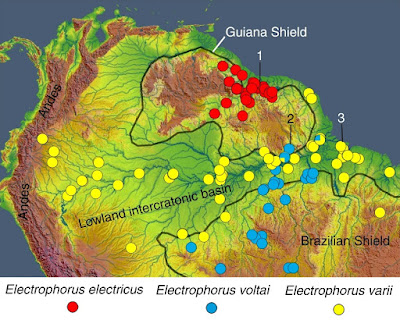 |
| Electrophorus voltai
de Santana, Wosiacki, Crampton, Sabaj, Dillman, Castro e Castro, Bastos and Vari
de Santana, Crampton, Dillman, Frederico, Sabaj, et al., 2019.
|
Abstract
Is there only one electric eel species? For two and a half centuries since its description by Linnaeus, Electrophorus electricus has captivated humankind by its capacity to generate strong electric discharges. Despite the importance of Electrophorus in multiple fields of science, the possibility of additional species-level diversity in the genus, which could also reveal a hidden variety of substances and bioelectrogenic functions, has hitherto not been explored. Here, based on overwhelming patterns of genetic, morphological, and ecological data, we reject the hypothesis of a single species broadly distributed throughout Greater Amazonia. Our analyses readily identify three major lineages that diverged during the Miocene and Pliocene—two of which warrant recognition as new species. For one of the new species, we recorded a discharge of 860 V, well above 650 V previously cited for Electrophorus, making it the strongest living bioelectricity generator.
Systematic biology
Electrophorus Gill, 1864
Type species: Gymnotus electricus Linnaeus, 1766.
Electrophorus electricus (Linnaeus, 1766)
Diagnosis: Ten nucleotides in COI (BOL-COIfishF1/R1; 569-bp fragment): G(8), A(50), T(76), T(77), T(107), C(119), C(182), G(272), G(494), A(560). Ventral outline of head U-shaped, widest at terminus of branchial opening (Fig. 2a) and lateral-line pores 88–101 (versus ovoid, widest anterior to branchial opening, Fig. 2b; 112–146 in E. voltai). Distinguished by skull depressed, cleithrum lies between vertebrae 5 and 6 (Fig. 2a), pectoral-fin rays 32–38, and lateral-line pores 88–101 (versus skull deep, cleithrum lies between vertebrae 1 and 2, Fig. 2c, 20–28, and 124–186 in E. varii, respectively).
Electrophorus varii, sp. nov. de Santana, Wosiacki, Crampton, Sabaj, Dillman, Mendes-Júnior and Castro e Castro
Etymology: In honor of Richard Peter Vari (1949–2016) for his contributions to ichthyology.
Diagnosis: Eleven nucleotides in COI: A(64), A(80), G(146), G(164), T(190), A(251), A(467), C(512), T(517), A(536), and C(569). Pectoral-fin rays 20–28 and lateral-line pores 124–186 (versus 32–38, and 88–101, respectively, in E. electricus). Distinguished by head narrow, Fig. 2a (versus wide, Fig. 2b, in E. voltai; distance between medial margins of contralateral dentaries at transverse through last two ventral pores 2–3 times shorter in E. varii than E. voltai, Fig. 2a, b), skull deep, cleithrum lies between vertebrae 1 and 2, Fig. 2b (versus skull depressed, cleithrum lies between vertebrae 5 and 6, in both E. electricus and E. voltai Fig. 2a, c).
Electrophorus voltai, sp. nov. de Santana, Wosiacki, Crampton, Sabaj, Dillman, Castro e Castro, Bastos and Vari
Etymology: In honor of Alessandro Giuseppe Antonio Anastasio Volta (1745–1827).
Diagnosis: Eight nucleotides in COI: A(25), C(29), C(50), C(86), C(140), A(230), A(338), and C(545). Ventral outline of head ovoid, widest anterior to branchial opening (Fig. 2b) and lateral-line pores 112–146 (versus U-shaped, Fig. 2a, 88–101 in E. electricus). Distinguished by skull depressed, cleithrum lies between vertebrae 5 and 6; and head wide (versus skull deep, cleithrum lies between vertebrae 1 and 2, Fig. 2b, and head narrow in E. varii), and distance between medial margins of contralateral dentaries at transverse through last two ventral pores 2–3 times longer in E. voltai than in E. varii, Fig. 2b, c.
C. David de Santana, William G. R. Crampton, Casey B. Dillman, Renata G. Frederico, Mark H. Sabaj, Raphaël Covain, Jonathan Ready, Jansen Zuanon, Renildo R. de Oliveira, Raimundo N. Mendes-Júnior, Douglas A. Bastos, Tulio F. Teixeira, Jan Mol, Willian Ohara, Natália Castro e Castro, Luiz A. Peixoto, Cleusa Nagamachi, Leandro Sousa, Luciano F. A. Montag, Frank Ribeiro, Joseph C. Waddell, Nivaldo M. Piorsky, Richard P. Vari and Wolmar B. Wosiacki. 2019. Unexpected Species Diversity in Electric Eels with A Description of the Strongest Living Bioelectricity Generator. Nature Communications. 10; 4000. DOI: 10.1038/s41467-019-11690-z
Smithsonian Scientists Triple Number of Known Electric Eel Species https://www.si.edu/newsdesk/releases/smithsonian-scientists-triple-number-known-electric-eel-species via @Smithsonian
Electric eels are naked-back knifefishes (Gymnotidae) and are more closely related to catfish and carp than to other eel families.
The study, published in Nature Communications, not only provides new knowledge about the animal more than 250 years after it was first described but also opens up new avenues of research into the origin and production of strong electric discharges in other fish species.
Gymnotiformes, the knifefish family to which Gymnotidae belong, are native to Mexico and South America, are found almost exclusively in freshwater habitats, and are mostly nocturnal. There are currently approximately 250 valid gymnotiform species among 34 genera and five families.
A new species of electric eel produces the highest voltage discharge of any known animal phys.org/news/2019-09-species-electric-eel-highest-voltage.html via @physorg_com






